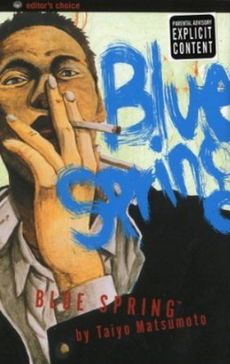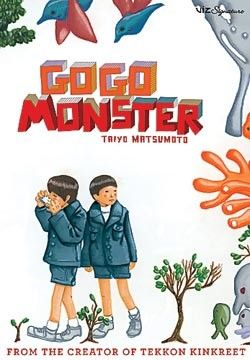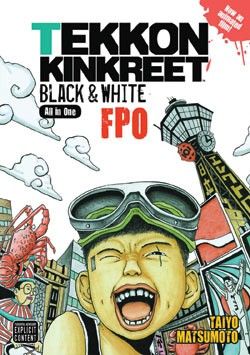This week, I thought I'd take a look at the artist Taiyo Matsumoto. Matsumoto has only 4 works available in English, and the last new work was released over three years ago. But he's quite an extraordinary artist. His art is heavily influenced by European comics, something you don't often see among the manga artists available in English, and he uses intricate detail combined with an extremely fluid and heavily fantastic style. His backgrounds in particular are highly original and detailed. His stories are equally fantastic, and the ones available in English range from gritty crime to post-apocalyptic conflict. His series also tend to get released in very nice-looking graphic novel collections
In addition to the three I mention below, there are also 2 volumes of a series called No. 5 available, and a series called Sunny will be appearing in May.
Blue Spring - Taiyo Matsumoto (1 volume)
Blue Spring is a collection of short stories, and includes some of Matsumoto's earliest work. They all lean fairly heavily on the crime/yakuza side, and can be very bleak, but it's still a surprisingly polished collection of early work. His artwork isn't quite as sophisticated, but the stories are still nice to look at, and one of my favorite details is the amount of graffiti that appears in the background of nearly every panel of some stories. Translation footnotes clutter the page, which is unfortunate, but the art is still nice. The first story in the volume is probably the best. Titled "If You're Happy and You Know It, Clap Your Hands!", it's about a group of boys at the bottom of the social order in their school trying to climb the ranks by playing a game where you hang upside down from the roof of the school and clap your hands. The school is rife with delinquency, which fits into the gritty crime feel of the other stories nicely. It's not the best of Matsumoto's work available in English, but it's still an unusual collection of short stories.
GoGo Monster - Taiyo Matsumoto (1 volume)
Bear with me on this one, because this story is complicated and difficult to describe in brief. The story is set in an all boys elementary school, and the main character is an outcast named Yuki. Yuki can see and hear beings from another dimension called Them and The Others. He frequently talks to them, and entertains them by playing his harmonica. Because nobody else can see Them or The Others, Yuki is made into a pariah, which becomes increasingly frustrating when he begins insisting things are going awry at the school because The Others are taking over. Another outcast at the school is a boy named IQ, who is highly intelligent but is never seen without a box over his head. IQ insists that Them and The Others are just manifestations of Yuki's loneliness, but IQ is lonely and not altogether sane himself. A third boy, Makoto, is a completely normal boy that tries hard to make friends with both the others. The narrative progresses through the school year, and things turn surreal when IQ begins behaving erratically and Yuki's Others begin a "takeover." There are downright psychedelic moments where IQ and Yuki may or may not travel through their own consciousnesses, but as the narrative begins becoming increasingly unhinged, Makoto, the normal one, gives us a perspective that is more inline with reality, so it never gets completely out of hand. I know I haven't adequately summarized this, but it's difficult to explain, and is one of those types of stories you simply need to experience for yourself. Admittedly, much is also left up to reader interpretation at the end of the story, and you are left to judge what is reality and what occurred entirely in the minds of the boys. This is the most current of Matsumoto's work in English, and as such the artwork is top notch. Broken glass and graffiti are frequent motifs throughout, and they link sections of the story together and fluctuate as the narrative comes more unhinged. The book itself is also beautiful. It was released as a single hardcover in a slipcase that displays the fore-edge, dyed to continue the designs that make up the wraparound cover illustration.
Tekkon Kinkreet, aka Black & White - Taiyo Matsumoto (Tekkon Kinkreet is a 1-volume omnibus, Black & White is 3 volumes)
Tekkon Kinkreet is an early work by Matsumoto, and has two editions in English (the Tekkon Kinkreet omnibus is the superior edition). Early though it may be, it's also the best of what I've read by him, and it's fantastic in terms of both art and story. The story is set in a crime-ridden city more or less ruled by two young boys, named Black and White. Black is the more aggressive of the two, and is the one that tends to beat up other, older boys. White is in a state of arrested development, and he tends to act as bait to lure other gangs to Black since he's seen as the weaker link. Black and White are head of the younger thugs in the city, but the story also involves the older yakuza-based gangs. Treasure Town is a bad place, but the story is about what happens when true evil takes over, and what needs to be done by the gangs in order to drive it out. It's another very surreal and crime-oriented story, but the characters in this one are very well done, and I find Matsumoto's art here to be the best that I've seen, especially since the later GoGo Monster takes place entirely in a school, which doesn't lend itself to Matsumoto's strengths. One of my favorite details is that many of the characters smile all the time, which is often in stark contrast to the terrible things going on. Even the cover is made more appealing by Black's huge grin. It's a fantastic series, and I'd recommend it to anyone that wants to read an unusual and surreal crime story. It should still be in print, too.




